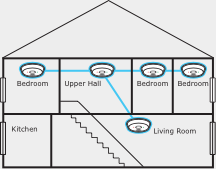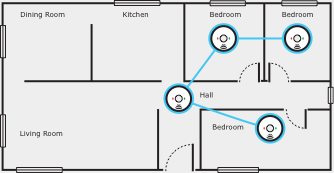Clipsal Firetek Smoke Alarms
Fully installed
Interconnected
Photoelectric
240V mains powered
9V Battery Backup
5 year manufacturer’s warranty
Compliant with 2022 QLD legislation
*Contact us for an obligation free quote today!

0408 839 006
From 1 January 2017
Landlords are responsible for the installation of smoke alarms that comply with new Smoke Alarm legislation, introduced on 1 January, 2017.
Existing smoke alarms manufactured more than 10 years ago, as well as any smoke alarms that do not operate when tested, must be replaced with photoelectric smoke alarms that comply with Australian Standard 3786–2014.
From 1 January 2022
From 1 January 2022, at the commencement of a new lease or lease renewal, you must ensure your dwelling / unit meets the requirements of the domestic smoke alarm legislation. This may involve installing interconnected photoelectric smoke alarms into the bedrooms in addition to the currently required smoke alarms.
From 1 January 2017
Existing smoke alarms manufactured more than 10 years ago must be replaced with photoelectric smoke alarms which comply with Australian Standards (AS) 3786-2014. (Note: the date should be stamped on the back)
Smoke alarms that do not operate when tested must be replaced immediately.
Existing hardwired smoke alarms that need replacement, must be replaced with a hardwired photoelectric smoke alarm.
From 1 January 2027
All existing private homes, townhouses and units will require photoelectric interconnected smoke alarms. These must be either a hardwired (eg. 240v) or non-removable 10 year battery powered type alarm.
The legislation requires smoke alarms must be installed in the following locations:
on each storey
in each bedroom
in hallways that connect bedrooms and the rest of the dwelling
if there is no hallway, between the bedroom and other parts of the storey; and
if there are no bedrooms on a storey, at least one smoke alarm must be installed in the most likely path of travel to exit the dwelling.
From 1 January 2017
As part of a building approval process, requiring a Building Certifier, all new homes and renovations should have the required smoke alarms installed pursuant to the requirements of the National Construction Code (NCC) formally known as Building Code of Australia (BCA) and the Building Regulation 2006.
What are the standard requirements?
Smoke alarms in the dwelling must:
be photoelectric (AS3786-2014); and
not also contain an ionisation sensor; and
be hardwired to the mains power supply with a secondary power source (i.e. battery); and
be interconnected with every other smoke alarm in the dwelling so all activate together.
The legislation requires smoke alarms must be installed in the following locations:
on each storey
in each bedroomin hallways that connect bedrooms and the rest of the dwelling
if there is no hallway, between the bedroom and other parts of the storey; and
if there are no bedrooms on a storey, at least one smoke alarm must be installed in the most likely path of travel to exit the dwelling.
Smoke alarms must be hardwired, or for existing dwellings, they can also be powered by a non-removable 10-year battery.
From 1 January 2017
Existing smoke alarms manufactured more than 10 years ago must be replaced with photoelectric smoke alarms which comply with Australian Standards (AS) 3786-2014. (Note: the date should be stamped on the back)
Smoke alarms that do not operate when tested must be replaced immediately.
Existing hardwired smoke alarms that need replacement, must be replaced with a hardwired photoelectric smoke alarm.
Existing landlord’s and tenant’s obligations continue. Property sellers must continue to lodge a Form 24 stating the requirements of the legislation have been met.
From 1 January 2022
All homes or units being sold or leased, or existing leases renewed, will require hardwired photoelectric, interconnected smoke alarms. Non-removable 10-year battery smoke alarms can be installed in place.
Smoke alarms in the dwelling must:
be photoelectric (AS3786-2014); and
not also contain an ionisation sensor; and
Be hardwired to the mains power supply, if currently hardwired. Otherwise, smoke alarms can be either hardwired or powered by a non removable 10 yr battery or a combination of both.
be interconnected with every other smoke alarm in the dwelling so all activate together.
The legislation requires smoke alarms must be installed in the following locations:
on each storey
in each bedroom
if there is no hallway, between the bedroom and other parts of the storey; and
if there are no bedrooms on a storey, at least one smoke alarm must be installed in the most likely path of travel to exit the dwelling.


When it is time for your property's alarms to be upgraded, those alarms must:
be photoelectric and comply with Australian Standard 3786-2014
not also contain an ionisation sensor; and
be less than 10 years old; and
operate when tested; and
be interconnected with every other ‘required’ smoke alarm in the dwelling so all activate together.
Any existing smoke alarm being replaced from 1 January 2017 must be a photoelectric-type alarm which complies with Australian Standard 3786-2014.
If a smoke alarm which is hardwired to the domestic power supply needs replacement, it must be replaced with a hardwired photoelectric smoke alarm.
In existing domestic dwellings, it is possible to have a combination of smoke alarms (240v and battery operated) and interconnectivity can be both wired and/or wireless.